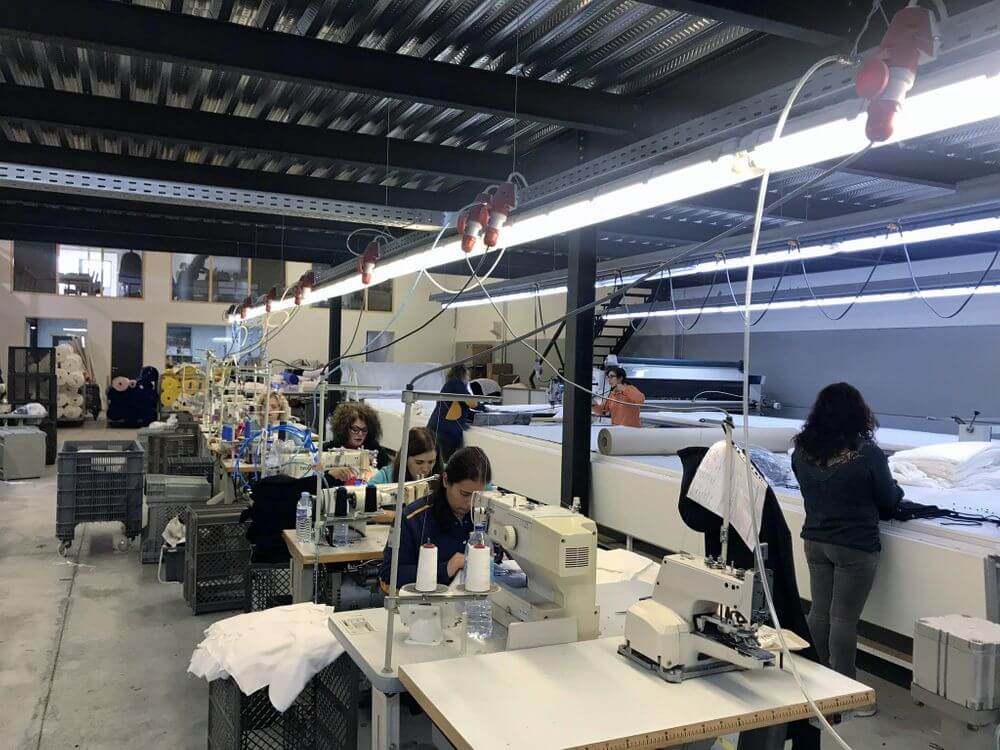Design, technology, and company are three terms that must be understood in the Fashion industry. None of them can be left behind or isolated from the others in a changing industry, which is in full revolution. A sector that has strongly joined the digital transformation to offer better services, procedures, and products to a consumer who has also changed and has evolved.
The fashion industry, in constant evolution, is currently experiencing its fourth industrial revolution and the boom in digital marketing and e-commerce. Proof of this is the data provided by the latest Fashion report on the Internet, prepared by the DKB Sector Observatory. At the end of 2019, it is expected that the sales of the sector in the network will grow by 36.5% and exceed 2.4 billion dollars in turnover, compared to 1,920 in 2017. Thus, fashion eCommerce has advanced positions multiplying by four the turnover in just five years, figures that reflect that online fashion is walking giant steps in North America.
New technologies have also come to the sector to stay. And revolutionize it. A new scenario where innovation in design processes has meant that in recent years the industry demands new professionals capable of handling new technologies applied in fashion. These technologies include new tools adapted to production such as virtual design and pattern design or artificial intelligence (AI) or augmented reality (AR), all of them with great potential to transform the distribution chain.
This is the case of Japanese software and hardware Shima Seiki, whose technology has landed in ESNE classrooms to train new professionals in the textile industry. It is a program that allows virtual simulation of fabric, saving production before its sale, and then applying it to a pattern applied in three dimensions on an avatar, which allows obtaining a virtual prototype before making it. Multinationals such as INDITEX or the Cortefiel Group have already incorporated this revolutionary technology into their daily lives.
The fashion sector has joined the digital transformation with the strength to offer better services and products to consumers. Big data, virtual design or eCommerce, are implemented in a traditional sector that seeks new horizons.
The incorporation of this type of technology reduces the time of both collections and samples, as well as its subsequent production since it is not necessary to make a physical prototype to verify the correct realization.
A panorama that requires educational programs focused on the training of professionals capable of leading this new digital era. This is the case of the Official Master’s Degree in Fashion: New Technologies and Digital Businesses, a postgraduate degree that aims to train experts in both the application of technology in fashion design and fashion management, communication and marketing in the current internet paradigm.
In this sense, ESNE, together with a large group of companies and the main associations of the sector, wants to lead the transformation of the Fashion business in North America as a result of the growing innovation in the sector and the unstoppable impact of e-commerce.
Technological Trends in The Fashion Sector
The fashion sector has joined the digital transformation with the strength to offer better services and products to its customers. Big Data, wearables or the Internet of Things are implemented in a traditional sector that seeks new goals.
The technological transformation is gradually spreading in all business sectors, which take advantage of the benefits of current innovation to apply it to their processes, services, and products.
In this article, we will analyze the evolution that the fashion sector is experiencing thanks to technology. Its implementation is an important step for the renovation of a very traditional sector that, already in recent years, had laid the foundations for the current change.
SMART TECHNOLOGY FOR STORAGE & SHIPPING
As is happening in other sectors, fashion is very skillfully accepting the potential offered by technology when organizing its stock and sending products from its stores. Traditional logistics centers, with a very high volume of garments to be able to meet the demand of customers, have become intelligent logistics centers with a much smaller amount of stock, with much more efficient facilities and with much lower energy expenditure.
This decrease of material in reserve has been possible thanks to the great knowledge on the part of companies and brands of their clients through the channelling of the information that they have of them. In this way, it is already possible to predict how much demand there will be each month or season, which garments will be the most requested and, consequently, adjust the stock of garments to the expected demand.
Also in the logistics centers, human resources have been modified and have incorporated engineers and data technicians or specialists in logistics technology and software.
If in global logistic terms the most popular case is that of Amazon centres, in the case of the fashion sector one of the best known is that of the North American Inditex, specifically its main brand, Zara, whose logistics platforms can identify the garments one by one throughout the process (from storage to sale). The responsible technology is RFID tagging, which allows you to locate any garment much faster, streamlines inventories and make shipments much faster.
BIG DATA: INFORMATION AT THE SERVICE OF PERSONALIZATION
Concerning the previous point, the Use of Big Data to analyze the tastes and consumption habits of potential customers has also allowed us to diversify products.
In this way, the stock of the big brands has gone from having large quantities of more generic and standard garments to having much less global quantity and much more variety of garments, adjusted to consumption habits of a much more diverse and plural audience.
Thus, brands tend much more to personalization or segmentation of their audience to offer them custom garments.
This can also be observed in geographical terms, as the main fashion chains vary the type of garments they offer in establishments in different countries, and even in the same city based on the neighbourhood and the customer profile of each area.
Also in terms of personalization, and far from the activity of the big brands, the good analysis of the data has allowed the creation of SMEs that focus on personalized attention to their customers.
Two interesting examples are Fashiop or Lookiero, which are based on a business model in which, through a remote personal advisor, they send a selection of clothing to the client’s home that fits their tastes and needs to be analyzed. The customer observes the clothes, keeps the clothes he wants and returns the rest without any cost.
The client-advisor relationship allows a level of closeness and knowledge of their habits that the client values very positively, generating confidence in the service. Gradually, and through the analysis of the information offered by the customer through their purchases, the company has a high volume of information that, well filtered, allows to improve loyalty with its buyers even more.
SMART CLOTHES ARRIVE
If we focus on products, clothing, we will observe that more and more technology will be incorporated naturally into its composition.
According to the latest report from ABI Research, the technological clothing market will exceed 18 million items in 2021, with an annual growth of 48%. On the other hand, another study of the University of Berkeley shows the growing evolution of smart clothes along with the rest of smart devices on the market. This has had a lot to do with the alliance that the main brands in the fashion sector have formed with the big technology firms.
Nowadays we can find t-shirts with adjustable temperatures for cyclists, gloves connected to batteries or garments that control vital signs. Wearable technology allows our garments to have devices with multiple functionalities.
Clothing that is illuminated with the electric current generated with inks on flexible substrates in garments is also a reality; or smart meshes or garments that, thanks to the implantation of sensors, detect the symptoms of fatigue in our back and modify their position to avoid lumbar injuries.
Sportswear has been one of the specific fields of fashion that has undergone more changes and more technological transformation. In the field of prevention, for example, sensors have also allowed the development of garments that monitor our vital signs and can detect our risks of suffering from cardiovascular problems.
In the era of the Internet of Things, the information that smart garments can collect can also be sent automatically, for example, to mobile devices.
Children’s clothing is also subject to digital transformation, especially in aspects related to the health of children. An example is that of the Spanish brand Rapife, which specialized in underwear, which for example has developed a body that changes color when the child has a fever or some booties that measure the baby’s vital signs.
Amid all this boom in the fashion sector, some companies are choosing to design smart clothes. According to the latest report from ABI Research, the technological clothing market will exceed 18 million items in 2021, with an annual growth of 48%.
Globally known firms such as Levi’s or Ralph Lauren have initiated the development of this type of garment thanks to agreements with technology firms. In the case of Levi’s, Google is responsible for helping you design a jacket that will allow you to control your smartphone through the sleeve. Is this the clothes of the future?
FASHION STORES WITH ‘SMART’ TECHNOLOGY
Not only logistics or garments are intelligent, but fashion stores themselves are taking a high technological component in their composition. We should not be surprised if we enter a fitting room and find a touch device with which we can ask the clerk for another size or a different garment.
An interesting addition is that of Virtual Reality, with many possibilities in physical stores, which will allow establishments to display their garments with virtual projections and can show a much higher number of models than the current one, as a virtual catalog.
Another of the changes in the concept of physical stores is the possibility of buying and leaving without having to carry any garment. The idea is that the physical store serves us simply to check which garment we like and if it suits us, and then from the same store, we make the purchase through a device and wait for it to arrive home days later. We could say that the store would be a simple exhibitor or tester, but the purchase channel would be the internet, with a much more comfortable process for the buyer.
With a lot of ground to cover, the fashion sector already has multiple technological tools to offer products of higher quality and functionality and much more comfortable and complete services for consumers.
The technology of textile production and digital maturity.
Supply executives rate the maturity in the current digitalization of their organizations as low. It is not surprising that the great actors who were surveyed see themselves as more mature in digitalization than medium and small businesses. This result was repeated in all areas, but the difference between the largest and smallest firms was especially pronounced in terms of electronic sourcing, decisions on supplier countries, the integration of estimated cost in design and negotiation, portals of collaboration with suppliers and the greatest use of technology in textile production.
That indicates the need to invest in the latest process management technologies and integrate them. Returns can be significant: some software vendors claim that the new generation of GCVP systems can increase productivity up to 10 times.
Companies must promote a true change of mentality within their organizations and in their network of suppliers. This is critical to generate a transformation and move from a transactional approach to supplier relationships to true strategic partnerships; from supplying at the lowest FOB price to the management of value creation and the focus on the offer to the focus on the customer.
The change in mentality required is not limited to supply departments and suppliers, but extends to all other instances of product development, production and logistics.





